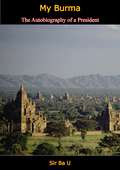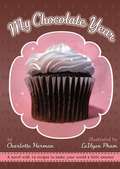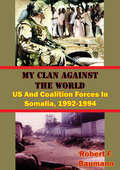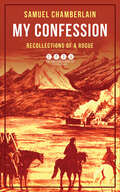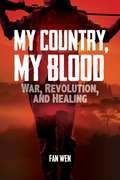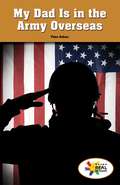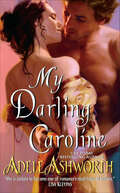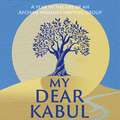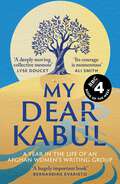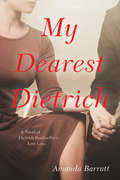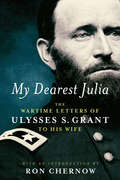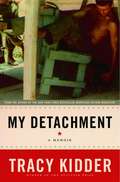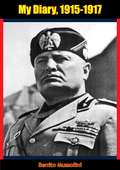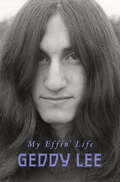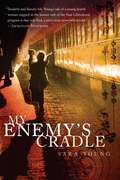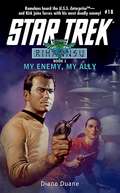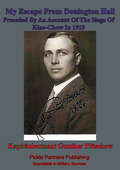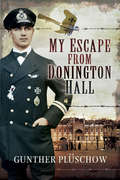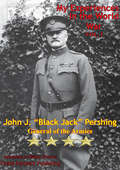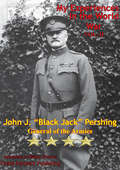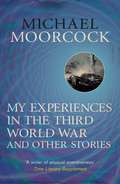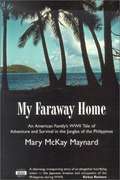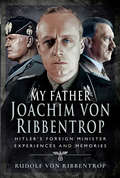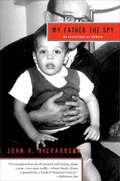- Table View
- List View
My Burma: The Autobiography of a President
by Sir Ba UOriginally published in 1958, this is the autobiography of the 2nd Present of Burma, U Ba U, who “rose under British rule to be a judge of the High Court of Judicature in Burma and, among the Burmese judges in the latest days of British rule, he was the only one to have received the dignity of knighthood.“When Burma attained independence, he became, as Chief Justice of the Supreme Court, the most authoritative guardian and guarantee for all the rights, inherited from British liberal traditions, which were conferred on the people under the Constitution and by law. Finally, by the unanimous vote of both Chambers of the Parliament in Joint Session, he was elected President of the Union, with precedence over all other persons throughout the Union, a position to which he has added further distinction by his judicious exercise of the powers and functions thereby conferred on him. […]One feature of his character which the story of his life reveals is a quiet determination to do his duty as he sees it, and this feature is further illustrated by the writing of this book.In view of the changes in Burma during his lifetime, in which he has personally taken no small part, such a record must necessarily be of historical importance. And the book must also find a place in the history of Burmese literature as almost the first essay by a Burman in the difficult art of autobiography.”
My Chocolate Year: A Novel with 12 Recipes
by Charlotte HermanDorrie Meyers is starting fifth grade, the year of the Sweet Semester baking and essay contest at school. Dorrie is determined to win, but her cakes fall flat, her cookies look like pancakes, and she learns the hard way that chocolate-covered gum is NOT a good idea. Then Dorrie meets her cousin Victor for the first time. Victor is an immigrant from Europe, and he is about to teach Dorrie that a loving family and a safe homeland are the sweetest things of all. With some top-secret tips from Victor's family's bakery and a big slice of confidence, Dorrie Meyers might just have the yummiest year of her life.
My Clan Against The World: US And Coalition Forces In Somalia, 1992-1994 [Illustrated Edition]
by Robert F. BaumannIncludes 12 maps and 8 tables"My Clan Against the World": US and Coalition Operations in Somalia, 1992-94 represents another in a series of military case studies published by the Combat Studies Institute (CSI) at Fort Leavenworth, Kansas. The impetus for this project came from the commanding general, US Army Training and Doctrine Command, Fort Monroe, Virginia, who directed CSI to examine the American military's experience with urban operations in Somalia, particularly in the capital city of Mogadishu...This case study also cautions against the misuse and overuse of "lessons" learned from any given military undertaking. As with the lessons of Vietnam, one of which dictated that conventional units should not engage in unconventional warfare, the US experience in Somalia left many military analysts and policymakers convinced that the U.S. should eschew any undertaking that smacked of nation building. Yet, as this book is published, just ten years after the US exit from Somalia, American forces are engaged in several locations against an unconventional foe and are involved in nation building in both Afghanistan and Iraq. Perhaps the first lesson to be learned about extracting lessons is, in the words of a once-popular motion picture, "Never Say Never Again."Another principal aim of the authors was to provide an analytical narrative of each phase of the US military involvement in Somalia. For many Americans, the mention of that African country conjures up one memory, that of the fierce firefight between US troops and Somali militia on 3-4 Oct. 1993. As this overview seeks to remind the reader, the U.S. had a military presence in Somalia from Dec. 1992 to the end of March 1994. During that period, much was accomplished of a positive nature. Starving and mistreated Somalis were provided food and a modicum of security, while some progress was made toward peace in the country.
My Confession: Recollections of a Rogue
by Samuel ChamberlainSamuel Chamberlain's My Confession is a quintessential American tale of a young man's escapades across the vastness of the Western Frontier. From humble beginnings in Boston, Chamberlain journeyed to Texas to fight in the Mexican-American War and eventually fell in with the notorious Glanton Gang, a brutal group of scalp-hunters immortalized in Cormac McCarthy's Western masterpiece Blood Meridian. Within these pages, Chamberlain leaves no stone unturned, providing an immersive account of the Mexican War, the unyielding men who fought in it, and a sobering portrait of unbridled lawlessness in the American frontier.
My Country, My Blood: War, Revolution, and Healing
by Fan WenWho is Zhao Xun? For those around him, the answer to this question is unclear. In KMT-occupied Kunming, Yunnan Province, a mist of uncertainty has already filled the air, and false names have become the norm. With the city&’s liberation at the hands of the Communist Army, this trend only intensifies. My Country, My Blood traces the life story of former KMT officer who spends his entire life living in Yunnan. It relays stories of opera troupes operating behind the frontlines, student groups resisting tyrannical governments, and the reshuffling of the social order that followed the Chinese Civil War. Grand in scope, My Country, My Blood pushes through the period of establishing a new government clear through to the time of healing marked by China&’s Opening Up to the world. Along the way, you will slowly piece together the puzzle of shifting pseudonyms, discovering who the characters actually are and the complicated, twisting paths that bring them together amid the throes of war. Painting a vibrant picture of how China came to be what it is today, My Country, My Blood is a story of war, revolution, and healing. As gripping as it is informative, this piece of fiction is truly a gem of modern Chinese literature.
My Dad is in the Army Overseas
by Titus SchorrThis non-fiction title supports and explains a child's world, reinforcing positive social messages around being a contributing family member, a good student, and a good citizen. When paired with its fiction title counterpart, it allows emerging readers to engage with both fiction and informational texts on the same subject matter, thus gaining different perspectives, new vocabulary, and new approaches to the same content.
My Darling Caroline
by Adele AshworthAn arranged marriage teaches a genius spinster a lesson about passion in this Regency romance by a USA Today–bestselling author.One by one, Lady Caroline Grayson watched her four sisters celebrate their betrothals, truly sure that marriage was not in her future—and perfectly pleased with that fact. Or so she thought.Brent Ravenscroft, Earl of Weymerth, nearly gave his life for the Crown. He returned to England a hero with no intention of taking a bride, certain his brusque demeanor would intimidate any young ladies drawn to his good looks—or so he thought.Bound by a business transaction, Caroline and Brent begin life as husband and wife. Utterly determined not to fall for each other, they stubbornly ignore the sparks flying between them and keep secrets at every turn. They would resist the lure of love—and the pleasures of the marriage bed—forever . . . or so they thought.“Remarkable. . . . An emotionally enthralling story. Readers will embrace these entertaining characters.” —Arnette Lamb
My Dear Kabul: The incredible and courageous diary of an Afghan women's writing group during the Fall of Kabul
by Untold Narratives CICThe incredible and courageous collective diary of an Afghan women's writing group during the Fall of Kabul in August 2021 'An intimate, courageous chronicle of life as it unfolds under Taliban rule'OBSERVER, *Book of the Day*'A hugely important book' BERNARDINE EVARISTO'A deeply moving collective memoir'LYSE DOUCETIn August 2021, as the Taliban approached the gates of Kabul, twenty-one women writers in Afghanistan came online in their WhatsApp chat group: they asked what news others had heard and if everyone was safe.These women had been brought together as a writing group. They were about to publish their first collection of short stories, while working regular day jobs. Some were students, some newly married, one was a grandmother: all were afraid of what was now to come. Over the next year, in the makeshift refuge of their WhatsApp group, they shared the day-to-day reality of life after a fall.Publishing on the anniversary of the Fall of Kabul, this is the women's courageous collective diary: in it the writers watch cities transform, schools close, families change and freedoms disappear. They share stories of chaos, protest and flight - and of life continuing. Check-points are a daily trial; men start behaving differently. Children can't afford the ice-cream man's wares; passports are near impossible to obtain. Together, their messages form a powerful chorus of resistance and solidarity.'Its courage is momentous'ALI SMITH
My Dear Kabul: The incredible and courageous diary of an Afghan women's writing group during the Fall of Kabul
by Untold Narratives CICThe incredible and courageous collective diary of an Afghan women's writing group during the Fall of Kabul in August 2021 'An intimate, courageous chronicle of life as it unfolds under Taliban rule'OBSERVER, *Book of the Day*'A hugely important book' BERNARDINE EVARISTO'A deeply moving collective memoir'LYSE DOUCETIn August 2021, as the Taliban approached the gates of Kabul, twenty-one women writers in Afghanistan came online in their WhatsApp chat group: they asked what news others had heard and if everyone was safe.These women had been brought together as a writing group. They were about to publish their first collection of short stories, while working regular day jobs. Some were students, some newly married, one was a grandmother: all were afraid of what was now to come. Over the next year, in the makeshift refuge of their WhatsApp group, they shared the day-to-day reality of life after a fall.Publishing on the anniversary of the Fall of Kabul, this is the women's courageous collective diary: in it the writers watch cities transform, schools close, families change and freedoms disappear. They share stories of chaos, protest and flight - and of life continuing. Check-points are a daily trial; men start behaving differently. Children can't afford the ice-cream man's wares; passports are near impossible to obtain. Together, their messages form a powerful chorus of resistance and solidarity.'Its courage is momentous'ALI SMITH
My Dear Kabul: The incredible and courageous diary of an Afghan women's writing group during the Fall of Kabul, as featured on Dua Lipa's Service95
by Untold Narratives CIC'A real-time, moving and intimate portrait of a year living under the Taliban, communicated via clandestine WhatsApp messages'SERVICE95'An intimate, courageous chronicle of life as it unfolds under Taliban rule'OBSERVER, *Book of the Day*'A hugely important book' BERNARDINE EVARISTO'A deeply moving collective memoir'LYSE DOUCETIn August 2021, as the Taliban approached the gates of Kabul, twenty-one women writers in Afghanistan came online in their WhatsApp chat group: they asked what news others had heard and if everyone was safe.These women had been brought together as a writing group. They were about to publish their first collection of short stories, while working regular day jobs. Some were students, some newly married, one was a grandmother: all were afraid of what was now to come. Over the next year, in the makeshift refuge of their WhatsApp group, they shared the day-to-day reality of life after a fall.Publishing on the anniversary of the Fall of Kabul, this is the women's courageous collective diary: in it the writers watch cities transform, schools close, families change and freedoms disappear. They share stories of chaos, protest and flight - and of life continuing. Check-points are a daily trial; men start behaving differently. Children can't afford the ice-cream man's wares; passports are near impossible to obtain. Together, their messages form a powerful chorus of resistance and solidarity.'Its courage is momentous'ALI SMITH
My Dearest Dietrich: A Novel of Dietrich Bonhoeffer’s Lost Love
by Amanda BarrattA staggering love illuminating the dark corners of a Nazi prisonRenowned German pastor and theologian Dietrich Bonhoeffer is famous for his resistance to the Nazi regime and for his allegiance to God over government. But what few realize is that the last years of his life also held a love story that rivals any romance novel.Maria von Wedemeyer knows the realities of war. Her beloved father and brother have both been killed on the battlefield. The last thing this spirited young woman needs is to fall for a man under constant surveillance by the Gestapo. How can she give another piece of her heart to a man so likely to share the same final fate? Yet when Dietrich Bonhoeffer, an old family friend, comes to comfort the von Wedemeyers after their losses, she discovers that love isn't always logical.Dietrich himself has determined to keep his distance from romantic attachments. There is too much work to be done for God, and his involvement in the conspiracy is far too important. But when he encounters a woman whose intelligence and conviction match his own, he's unprepared for how easy it is to give away his heart.With their deep love comes risk--and neither Dietrich nor Maria is prepared for just how great that risk soon becomes.Based on detailed historical research, this true love story is at once beautiful and heartrending. My Dearest Dietrich sheds new light on a world-famous theologian . . . and the woman who changed his life.
My Dearest Julia: The Wartime Letters Of Ulysses S. Grant To His Wife
by Ulysses S. Grant Ron ChernowThe Civil War's greatest general as you've never seen him before, in a revealing collection of letters to his wife Julia introduced by Ron Chernow.Ulysses S. Grant is justly celebrated as the author of one of the finest military autobiographies ever written, yet many readers of his Personal Memoirs are unaware that during his army years Grant wrote hundreds of intimate and revealing letters to his wife, Julia Dent Grant. Presented with an introduction by acclaimed biographer Ron Chernow, My Dearest Julia collects more than eighty of these letters, beginning with their engagement in 1844 and ending with the Union victory in 1865. They record Grant's first experience under fire in Mexico ("There is no great sport in having bullets flying about one in evry direction but I find they have less horror when among them than when in anticipation"), the aching homesickness that led him to resign from the peacetime army, and his rapid rise to high command during the Civil War. Often written in haste, sometimes within the sound of gunfire, his wartime letters vividly capture the immediacy and uncertainty of the conflict. Grant initially hoped for an early conclusion to the fighting, but then came to accept that the war would have no easy end. "The world has never seen so bloody or so protracted a battle as the one being fought," he wrote from Spotsylvania in 1864, "and I hope never will again."
My Detachment
by Tracy KidderIn an astonishingly honest, comic, and moving account of his tour of duty in Vietnam, master storyteller Tracy Kidder writes for the first time about himself. This extraordinary memoir is destined to become a classic. Kidder was a ROTC intelligence officer, just months out of college and expecting a stateside assignment, when his orders arrived for Vietnam. There, lovesick, anxious, and melancholic, he tried to assume command of his detachment, a ragtag band of eight more-or-less ungovernable men charged with reporting on enemy radio locations. He eventually learned not only to lead them but to laugh and drink with them as they shared the boredom, pointlessness, and fear of war. Together, they sought a ghostly enemy, homing in on radio transmissions and funneling intelligence gathered by others. Kidder realized that he would spend his time in Vietnam listening in on battle but never actually experiencing it. With remarkable clarity and with great detachment, Kidder looks back at himself from across three and a half decades, confessing how, as a young lieutenant, he sought to borrow from the tragedy around him and to imagine himself a romantic hero. Unrelentingly honest, rueful, and revealing, "My Detachment" gives us war without heroism, while preserving those rare moments of redeeming grace in the midst of lunacy and danger. The officers and men of "My Detachment" are not the sort of people who appear in war movies -- they are the ones who appear only in war, and they are unforgettable.
My Diary, 1915-1917
by Benito Mussolini Rita WellmanFrom the pages of his journal, the fascist Italian dictator recounts his experiences in the Army and at the front during the World War I years 1915-1917.First published in 1925 and written when he was a rifleman in the Italian Army, “Bersagliere Mussolini” recounts the vicissitudes of the trench life and dedicates My Diary, 1915-17 to his comrades of the trench: “It is mine and yours. My life and your life are in these pages; the monotonous, emotional, simple and exciting life we lived through together in the unforgettable days in the trenches.”
My Effin' Life
by Geddy LeeThe long-awaited memoir, generously illustrated with never-before-seen photos, from the iconic Rock and Roll Hall of Famer, Rush bassist, and New York Times bestselling author of Geddy Lee's Big Beautiful Book of Bass.Geddy Lee is one of rock and roll's most respected bassists. For nearly five decades, his playing and work as co-writer, vocalist and keyboardist has been an essential part of the success story of Canadian progressive rock trio Rush. Here for the first time is his account of life inside and outside the band.Long before Rush accumulated more consecutive gold and platinum records than any rock band after the Beatles and the Rolling Stones, before the seven Grammy nominations or the countless electrifying live performances across the globe, Geddy Lee was Gershon Eliezer Weinrib, after his grandfather was murdered in the Holocaust.As he recounts the transformation, Lee looks back on his family, in particular his loving parents and their horrific experiences as teenagers during World War II.He talks candidly about his childhood and the pursuit of music that led him to drop out of high school.He tracks the history of Rush which, after early struggles, exploded into one of the most beloved bands of all time.He shares intimate stories of his lifelong friendships with bandmates Alex Lifeson and Neil Peart—deeply mourning Peart’s recent passing—and reveals his obsessions in music and beyond.This rich brew of honesty, humor, and loss makes for a uniquely poignant memoir.
My Enemy's Cradle (Thorndike Reviewers' Choice Ser.)
by Sara YoungCyrla's neighbors have begun to whisper. Her cousin, Anneke, is pregnant and has passed the rigorous exams for admission to the Lebensborn, a maternity home for girls carrying German babies. But Anneke's soldier has disappeared, and Lebensborn babies are only ever released to their father's custody-- or taken away.A note is left under the mat. Someone knows that Cyrla, sent from Poland years before for safekeeping with her Dutch relatives, is Jewish. The Nazis are imposing more and more restrictions; she won't be safe there for long. And then in the space of an afternoon, life falls apart. Cyrla must choose between certain discovery in her cousin's home and taking Anneke's place in the Lebensborn--Cyrla and Anneke are nearly identical. If she takes refuge in the enemy's lair, can Cyrla fool the doctors, nurses, guards, and other mothers-to-be? Can she escape before they discover she is not who she claims? Mining a lost piece of history, Sara Young takes us deep into the lives of women living in the worst of times. Part love story and part elegy for the terrible choices we must often make to survive, MY ENEMY'S CRADLE keens for what we lose in war and sings for the hope we sometimes find.
My Enemy, My Ally: Rihannsu #1 (Star Trek: The Original Series #18)
by Diane DuaneAn electrifying thriller from bestselling author Diane Duane set in the Star Trek: The Original Series universe.Ael t' Rlailiiu is a noble and dangerous Romulan Commander. But when the Romulans kidnap Vulcans to genetically harness their mind power, Ael decides on treason. Captain Kirk, her old enemy, joins her in a secret pact to destroy the research laboratory and free the captive Vulcans. When the Romulans discover their plan, the Neutral Zone seethes with schemes and counter-schemes, sabotage and war.
My Escape From Donington Hall, Preceded By An Account Of The Siege Of Kiao-Chow In 1915
by Kapitänleutnant Gunther Plüschow"An outstanding story of the aerial war and a daring escape from captivity.For the uninitiated this book's original title, 'My Escape from Donnington Hall,' gave few clues as to the astonishing and unique nature of its contents. Its author was a young German, Gunther Plüschow. As an airman in German service at the outbreak of the First World War he was, unusually, serving in China flying a Rumpler-Taube aircraft from the East Asia naval station at Tsingtau that became besieged by joint Japanese and British forces. Plüschow's attempt to fly to safety, as it became obvious the position would fall, ended in a crash in rice paddies. He set out to walk back to Germany and the many adventures that followed would alone would qualify his story as a remarkable one. However, he was eventually captured and became a prisoner of war. Stories of wartime escape abound, but those who have been incarcerated in England have always been confounded by the difficulties of quitting an island.' In Plüschow's case this was exacerbated since in the east he had acquired a distinctive dragon tattoo; yet Plüschow he succeeded and is the only prisoner of war to escape from Britain and make the 'home run.' His remarkable narrative of his wartime adventures makes absolutely essential reading and is certainly beyond compare."-Leonaur Print version.Author -- Kapitänleutnant Gunther Plüschow 1886-1931.Translator -- Pauline De Chary. D. 1943Text taken, whole and complete, from the edition published in London, John Lane, 1922.Original Page Count - vii and 243 pages.Illustrations -- 2 Illustrations.
My Escape from Donington Hall: Preceded By An Account Of The Siege Of Kiao-chow In 1915
by Gunther PlüschowIt was an escape from a PoW camp as daring and fraught with danger as any immortalised by Hollywood. Yet the story is less familiar than most as it concerns the only German prisoner of war to escape from captivity in mainland Britain and make it home during either World War.After being caught in Gibraltar during an earlier attempt to return to his homeland, Pluschow and other captured Germans were shipped to Plymouth and then on to the PoW camp at Donington Hall, where he arrived in May 1915.On July 4 he and fellow prisoner Oskar Trefftz broke out by climbing over two 9ft barbed wire fences, before changing clothes and walking 15 miles to Derby where they caught a train to London.By the next morning the men's escape was featured in the Daily Sketch newspaper with both names and descriptions of the pair. They went their separate ways but Trefftz was recaptured at Millwall Docks. Realising he had to alter his appearance, Pluschow removed his smart tie and handed his coat in at the cloakroom at Blackfriars station. The German then used scraped-up coal dust, boot polish and Vaseline to change his fair hair to greasy black and covered himself in soot to make him appear as a dock worker. Pluschow then stowed away on a Dutch steamer ship at Tilbury docks, talked his way past a policeman in Holland before travelling to Germany by train. Upon his return home he received a hero's welcome and was presented with the Iron Cross First Class.This extraordinary story is told in Gunther's own words for the first time in English.
My Experiences In The World War – Vol. I [Illustrated Edition] (My Experiences In the World War #1)
by General of the Armies John Joseph PershingThe Pulitzer prize has been the sought after goal of many thousands of writers ever since it was first awarded in 1917. In 1932, the Pulitzer in the history category was awarded to General John "Black Jack" Pershing for his two volume memoirs spanning his time in command of the American Forces in World War One. Given that Pershing should receive such an illustrious prize in the literary arena outside of his army career was a just testament to his multi-faceted and outstanding talents. As the First World War raged into its fourth year, the lifeblood of the Allied forces on the Western Front laid spilt on the fields of Northern France and Flanders. Their only hope in facing the German onslaught lay in the newly mobilized American forces, who had joined the struggle against the central powers in Germany and Austro-Hungary. It would take a commander of towering strength, firm loyalty, and iron determination to change the small American peacetime army into the millions strong wartime colossus it was to become. Such a man was John "Black Jack" Pershing.AS he took command, Pershing was faced with four almightily difficult challenges to overcome in order to achieve success; the first to turn the raw American Doughboys into an army, trained in the new tactics of the industrial carnage of the Western Front. Secondly, to ship enough men, and supplies across the U-boat infested Atlantic to create such an army. Thirdly, to keep his allies hands off American manpower that became trained and ready for battle, they should fight under American flags and American leaders. It was only once the first three huge challenges were overcome could he think about his fourth, how his new troops could fight and beat the battle-hardened German army: but fight and beat them they did!A Pulitzer Prize winning classic!
My Experiences In The World War – Vol. II [Illustrated Edition] (My Experiences In the World War #2)
by General of the Armies John Joseph PershingThe Pulitzer prize has been the sought after goal of many thousands of writers ever since it was first awarded in 1917. In 1932, the Pulitzer in the history category was awarded to General John "Black Jack" Pershing for his two volume memoirs spanning his time in command of the American Forces in World War One. Given that Pershing should receive such an illustrious prize in the literary arena outside of his army career was a just testament to his multi-faceted and outstanding talents. As the First World War raged into its fourth year, the lifeblood of the Allied forces on the Western Front laid spilt on the fields of Northern France and Flanders. Their only hope in facing the German onslaught lay in the newly mobilized American forces, who had joined the struggle against the central powers in Germany and Austro-Hungary. It would take a commander of towering strength, firm loyalty, and iron determination to change the small American peacetime army into the millions strong wartime colossus it was to become. Such a man was John "Black Jack" Pershing.AS he took command, Pershing was faced with four almightily difficult challenges to overcome in order to achieve success; the first to turn the raw American Doughboys into an army, trained in the new tactics of the industrial carnage of the Western Front. Secondly, to ship enough men, and supplies across the U-boat infested Atlantic to create such an army. Thirdly, to keep his allies hands off American manpower that became trained and ready for battle, they should fight under American flags and American leaders. It was only once the first three huge challenges were overcome could he think about his fourth, how his new troops could fight and beat the battle-hardened German army: but fight and beat them they did!A Pulitzer Prize winning classic!
My Experiences in the Third World War and Other Stories: The Best Short Fiction Of Michael Moorcock Volume 1
by Michael MoorcockThe first part of Gollancz's definitive collection of Moorcock's short fiction, this selection features some of his finest work. From 'The Pleasure Garden of Felipe Sagittarius' to 'The Cairene Purse', the stories here are incredibly varied in their style, execution and subject matter.The stories included in this volume are: My Experiences in the Third World War Casablanca Going to Canada Leaving Pasadena Crossing into CambodiaThe MountainThe Deep FixThe Frozen CardinalWolfThe Pleasure Garden of Felipe SagittariusThe Real Life Mr NewmanThe Cairene Purse
My Faraway Home: An American Family's WWII Tale of Adventure and Survival in the Jungles of the Philippines
by Mary Mckay Maynard[From the back cover:] "When the Japanese bombed Pearl Harbor and attacked the Philippines, eight-year-old Mary McKay, her parents, and several other American families fled into the jungle for what they thought would be a short evacuation until they could be rescued by the Navy. Their wait lasted two years. My Faraway Home is the fascinating story of how they survived. Encountering typhoons, fires, and cobras, they lived on dwindling stores of canned food, traded with loyal Filipino villagers who wouldn't betray their hideout, and learned to improvise their own shoes (from rubber tyres), soap (from pig fat), and other necessities. Like the classics The Diary of Anne Frank or Empire of the Sun, My Faraway Home gives a fresh perspective on war through a child's eyes."
My Father Joachim von Ribbentrop: Hitler's Foreign Minister, Experiences and Memories
by Rudolf von RibbentropIn this memoir, the son of Nazi Germany&’s foreign minister looks back on his life, examining their relationship and his father&’s role in World War II. On 16 October 1946, Joachim von Ribbentrop, Hitler&’s wartime Foreign Minister, was executed at Nuremberg, convicted on four counts including deliberately planning a war of aggression and war crimes. In this first English language edition of his memoirs, Rudolf von Ribbentrop candidly describes his relationship with his father when he was the German Ambassador in London and during the war years. Von Ribbentrop was an often-isolated figure among the Nazi elite. In his final report from London, von Ribbentrop informed Hitler that he was convinced Great Britain would fight for its position in the world. He went on to play a key role forging the short-lived pact with Stalin&’s Soviet Union. Far from being uncritical, the author sets out to paint an objective picture of his father&’s role. His unique position sheds light on the unfolding dramatic events leading up to, and then the execution of, the Second World war. While the author briefly describes his personal experiences including his war service with the SS, it is the insight this work provides into top level decision making at the heart of the Third Reich that will appeal most to both historians and laymen.
My Father the Spy: An Investigative Memoir
by John H. RichardsonAs his father nears death in his retirement home in Mexico, John H. Richardson begins to unravel a life filled with drama and secrecy. John Sr. was a CIA "chief of station" on some of the hottest assignments of the Cold War, from the back alleys of occupied Vienna to the jungles of the Philippines—and especially Saigon, where he became a pivotal player in the turning point of the Vietnam War: the overthrow of South Vietnamese president Ngo Dinh Diem. As John Jr. and his sister came of age in exotic postings across the world, they struggled to accommodate themselves to their driven, distant father, and their conflict opens a window on the tumult of the sixties and Vietnam. Through the daily happenings at home and his father's actions, reconstructed from declassified documents as well as extensive interviews with former spies and government officials, Richardson reveals the innermost workings of a family enmeshed in the Cold War—and the deeper war that turns the world of the fathers into the world of the sons.
